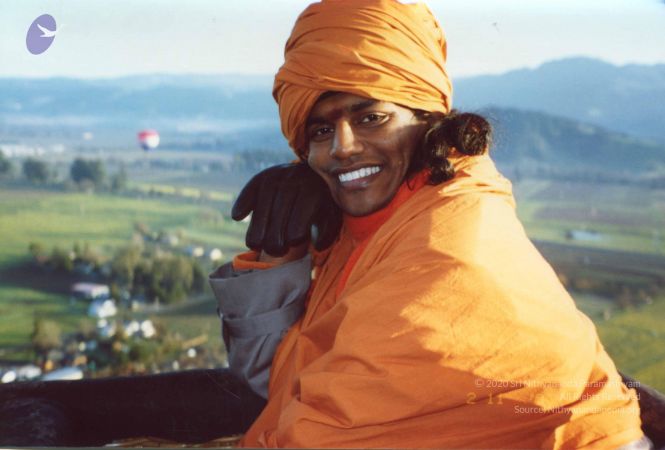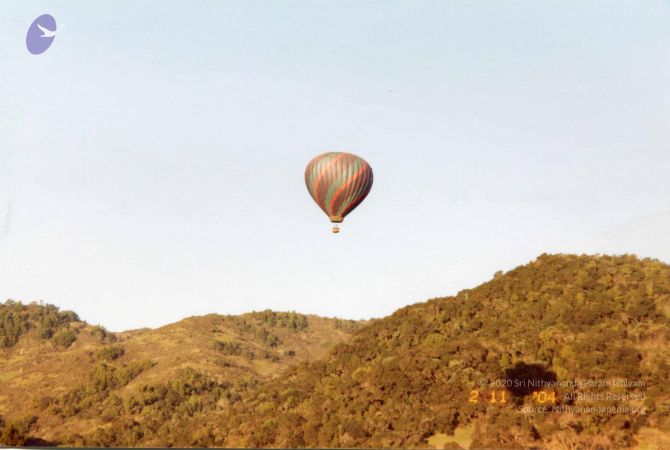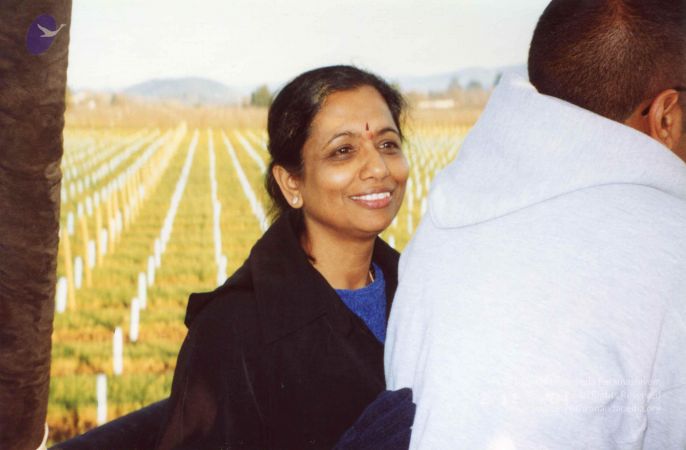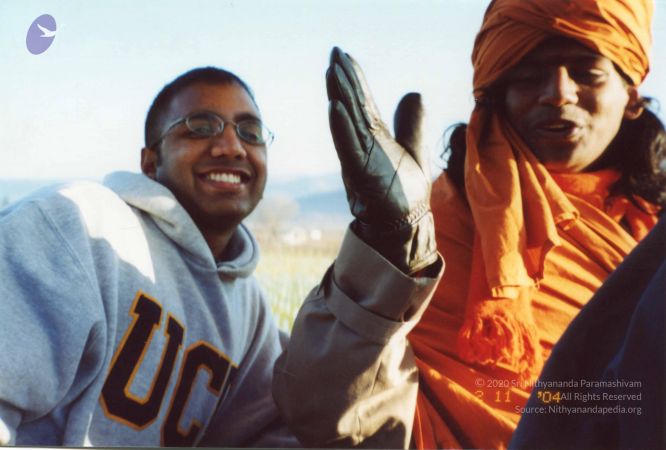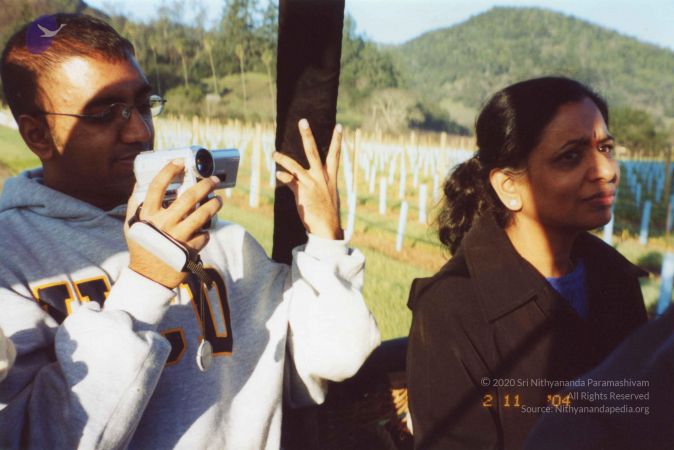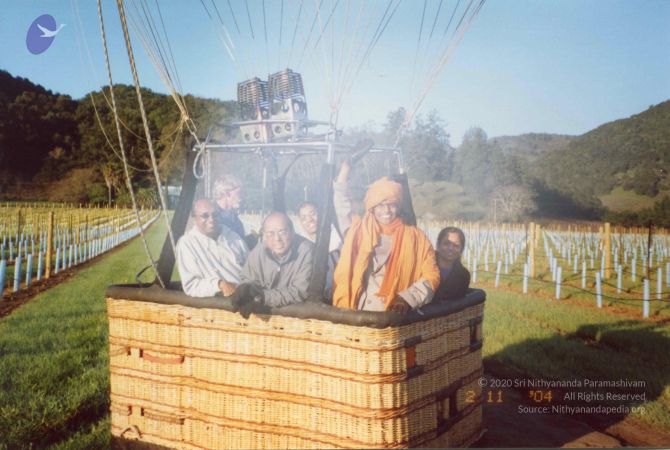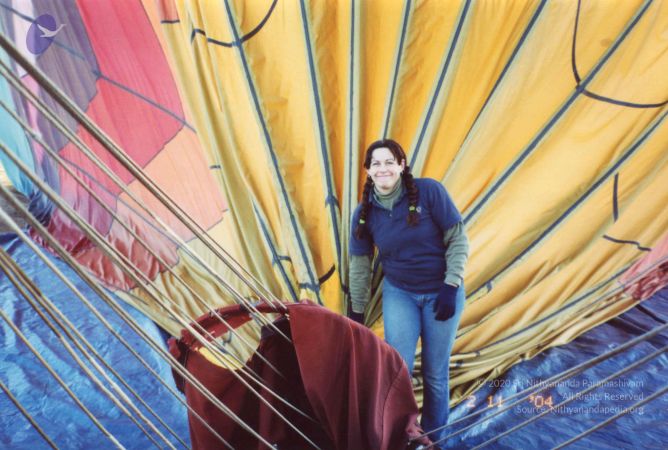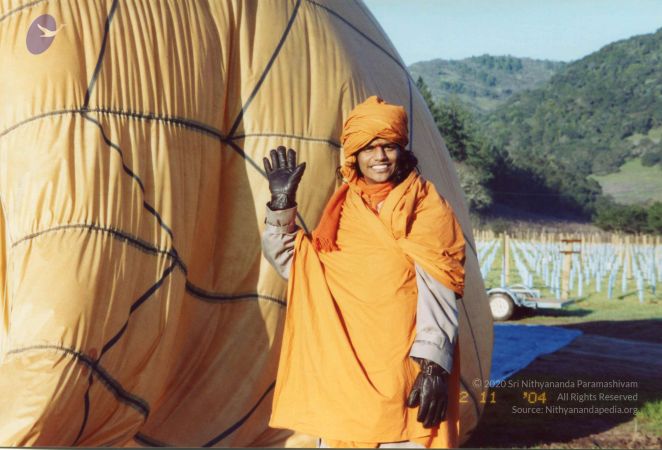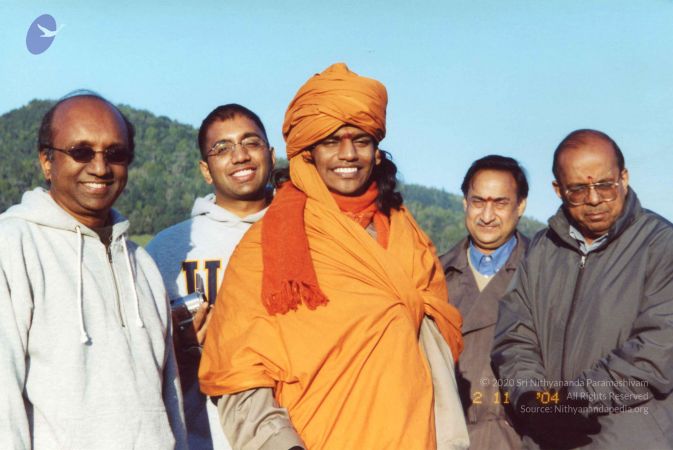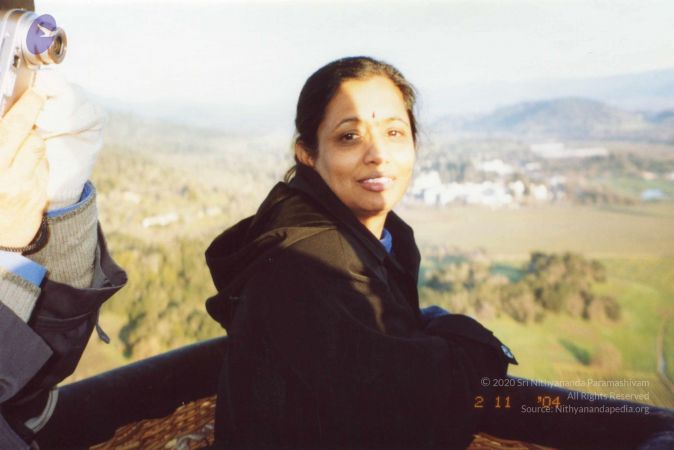Difference between revisions of "February 11 2004"
| Line 174: | Line 174: | ||
|alignment=center }} | |alignment=center }} | ||
| + | ==Transcript== | ||
| + | |||
| + | (0:16) | ||
| + | |||
| + | Now it is time for us to enter into a meditation technique. It’s a very small meditation technique, just 15 minutes. It is not that technique is 15 minutes; you are going to practice it throughout the day; I am just going to show you how to do it. So it’s just a simple technique. I’ll show you how to do it. It’s a very simple technique. In the, throughout the day you can continue to practice. | ||
| + | First thing: we’ll take few minutes to balance your body, to understand the Asanam. Asana means you should not have any pain or uneasiness in the body. How to do that? After sitting in a comfortable position from the toe to body, just remember your whole body and feel whether it is comfortable or not, whether it is relaxed or not. if you feel your knee is not relaxed, just tense it and relax. You will see that it will fall in relaxation. You should just check your whole body for 2-3 minutes and feel whether it’s comfortable or not. That's the first step. Please listen, then you can do it. | ||
| + | The next step: start very slow steady deep breathing - Pranayama. | ||
| + | Third step: your inner chattering, from where your inner chattering or thinking starts just be there. Just watch from where your thoughts come, any thought may come, don’t suppress it. Whether it is good or bad don’t label it. Any thought may come just watch it. These are the 3 steps Asana, Pranayama, Pratyahara. | ||
| + | |||
| + | (2:09) | ||
| + | |||
| + | First we shall sit straight. Close your eyes. | ||
| + | Close your eyes, sit straight. | ||
| + | Meditation Process begins... | ||
| + | Om Nithyananda Paramashivoham | ||
| + | |||
| + | See from the toe, first check the legs if you are comfortable. Come up... whether your feet are comfortable or not. Just give instruction to your feet - please be relaxed. Your body will simply obey you. Just tell your body, tell your feet please be relaxed. Tell your ankles please be relaxed tell your knees please be relaxed. | ||
| + | |||
| + | Tell your thighs to be relaxed. Tell your hips to be relaxed. Guide your stomach to be relaxed. | ||
| + | |||
| + | Tell your chest to be relaxed. Tell your neck to be relaxed. Tell your face to be relaxed. Tell your body totally to be relaxed and comfortable. Start observing your breath. Sart as deeply as possible breathing. Start breathing as deeply as possible to touch your navel. | ||
| + | |||
| + | Start breathing as deeply as possible... as deeply as possible. | ||
| + | |||
| + | Start watching your thoughts. From where your thoughts raise... just see the root from where your thoughts raise. | ||
| + | |||
| + | Watch near your navel center, that is the place where thoughts raise. Watch as deeply as possible. | ||
| + | |||
| + | Watch as deeply as possible. | ||
| + | |||
| + | (14:36) | ||
| + | |||
| + | Om Shanti Shanti Shantihi. Relax, you can open your eyes. Do this throughout the day that’s enough. Whenever you remember, start practicing it. Don’t create guilt ‘Oh, I have forgotten’. Then again that’ll become one more thought. Whenever you remember, just watch your thoughts, what is happening. So let you have this meditation and let this understanding work miracles inside you. Let you enter, and be, and become Nithyananda. Thank you. | ||
| + | |||
| + | (15:26) | ||
| + | |||
==Title== | ==Title== | ||
| Line 185: | Line 221: | ||
|alignment=center }} | |alignment=center }} | ||
| + | ==Transcript== | ||
| + | |||
| + | (0:16) | ||
| + | |||
| + | Q: Swamiji, what is the difference between Vipasana(sitting in silence) and Upasana (chanting of mantras)? | ||
| + | |||
| + | (00:26) | ||
| + | |||
| + | Swamiji: There are two things. Vipasana and Upasana. Upasana means chanting the mantra. Vipasana means paying attention to the breath. When you chant the mantra, naturally all your inner chattering gets slowly, slowly reduced, and your mind is focused on one mantra. Finally you have to come out of that word also to reach the wordlessness or the Bliss. Wordlessness is Bliss. | ||
| + | |||
| + | (00:57) | ||
| + | |||
| + | With Upasana, with mantra, you concentrate all the power in one place, one thought, then you try to escape from that thought also. That is the one step. In Vipasana, you directly slip into that Bliss, thoughtlessness. When you observe the breath, when you put your concentration on the breath, directly you will see, you reach the place where there is no thoughts. That is the difference. Ofcourse, these are such subtle techniques only by practice you will be able to understand. Looks very simple. The technique when you put the thing into practice, then you will be able to understand. | ||
| + | |||
| + | (01:40) | ||
| + | |||
| + | With mantra, your whole mind will be concentrated on one word. Instead of one thousand word, one word. Then from that one word also you will escape. You will enter into wordlessness. With breath watch, with Vipasana, from the very beginning, you will see, you are slowly, slowly entering into the wordless state or the wordless Bliss. The inner chattering becomes lesser and lesser. The traffic becomes lesser and lesser. The awareness, the moments of awareness becomes more and more, and even without inner chattering you will be able to live joyfully, happily. You will run your regular life, a normal life but without worry and the inner chattering. You will be there as it is, just bubbling, energetic. | ||
| + | |||
| + | (02:24) | ||
| + | |||
| + | Vipasana is a direct technique, because I can say, Upasana has made many people enlightened no doubt but the Vipasana has made most people enlightened. In the mantra, your effort is necessary continuously. With Vipasana, after some time, it becomes a total energy phenomena. Instead of you doing it, that will start doing you. To catch the fire, it is very easy. To catch the glimpse of the awareness, to get the blueprint of Enlightenment, blueprint of Enlightenment only I call it as a first experience, Satori. To get the blueprint of Enlightenment, it will be easy through Vipasana than through Upasana. | ||
| + | |||
| + | (03:14) | ||
| + | |||
==Title== | ==Title== | ||
| Line 194: | Line 254: | ||
|alignment=center }} | |alignment=center }} | ||
| + | ==Transcript== | ||
| + | |||
| + | (0:16) | ||
| + | |||
| + | Q: Swamiji, how to find out whether a mantra is suitable for me or not? | ||
| + | |||
| + | (00:24) | ||
| + | |||
| + | SWAMIJI: The one simple thing, whenever you chant that mantra, you will feel a easy, relaxed, smoothness. See, your breath has got a capacity to continue till your words end. You need to understand two things. In your inner chattering, when you talk to yourself, in some place you will see, after two-three words also, your breath will be continuing. At one some point, within two-three words, your inner chattering will be broken, you will have breath and then you start talking. | ||
| + | |||
| + | (1:03) | ||
| + | |||
| + | You understand, it is a very deep phenomena, subtle phenomena. You need to understand. See, whenever you are talking with yourself, at some time, you will see, every one word, every one thought your body will be taking the breath. Sometime, even continuously for six-seven words, your body will not be taking the breath. | ||
| + | |||
| + | (1:28) | ||
| + | |||
| + | Your breath and your inner chattering has got a close connection. Sit silently and try to chant that mantra. Till full mantra, if your body does not take the breath, does not feel uncomfortable, if your body is allowing you to continuously chant the mantra, then mantra will work for you. | ||
| + | |||
| + | (1:50) | ||
| + | |||
| + | For some people, if they take ‘Namo Narayana’, by the time they come ‘nara,’ the breath will break. And then, they have to stop and then say, ‘enaye’. For some people, ‘Om Namah Shivaya’, in that Namah Shivaya, va itself, the breath will break. So, this is the one method to find out to whether the mantra is going to suit for you or not. Only these two things. If you chant consciously, any mantra will help you. If you chant unconsciously, no mantra is going to help you. Even if your Guru is powerful Guru, highly powerful Guru, Enlightened, no problem; If YOU don’t practice it, nothing can happen. Only you have to do it consciously. | ||
| + | |||
| + | (2:38) | ||
| + | |||
Revision as of 01:41, 8 April 2021
Title
Path of Meditation || Part 1 || (California)
Description:
In this video Supreme Pontiff of Hinduism HDH #Nithyananda Paramashivam Explains the various States of #Mind and how our Mind works.
Swamiji Explains Powerful truths about Four states of #consciousness, that human beings experience regularly are waking state, dream state, deep sleep state, and the fourth state, Turiya, the state of enlightened beings.
He went on to explain about Aparoksha jnana, the #Knowledge which is gathered, and Aparoksha jnana the knowledge which is Experienced.
Spirituality does not have any faith; it is rooted in Cosmic Truth.
Also Described the Details of Iyama, Niyama, Asana, Pranayama, Pratyahara, Dharana, Dhyana, samadhi Patanjali is an unabridged dictionary of world philosophy. Iyama: has five branches, ahimsa Non-violence, Astheya, non-stealing, Sathya, truthfulness, aparigraha, living with less, and brahmacharya, living like a God on planet earth, which includes celibacy.
While Expressing the Quality of the Mind, Swamiji simply explains that ‘’Mind and energy is like a mother in law and daughter in law, if you try to make them silent, they will fight more. They both are possessed by each other in the same way your mind is possessed by the consciousness’’
You can say yes to only one person, not to two-people.In the same way, if you say yes to the mind you will say no to meditation. When you get solidified, you get integrated, when you let go of your mind, it goes it's own way.
Only when you live Sathya, truthfulness, in mind, word, and deed, is it authentic.
The Whole perspective of science towards the east and spirituality, is the last word of science, ‘’everything that exists is energy’’. Where science ends spirituality starts.
When you live your life according to others’ choices or opinions you make your whole life a lie, and do not live the life you took birth for. At End, he also Explains about Varnashrama Dharma - The Ancient Varana System, which was Beautifully holding the Structure of the Society in its Authenticity. And in course time it got diluted by an Anti-HIndu Elements.
Video & Audio - Path of Meditation || Part 1
| Video | Audio |
Video & Audio - Path of Meditation || Part 2
| Video | Audio |
Video & Audio - Path of Meditation || Part 3
| Video | Audio |
Title
The Key to Your Life Energy || Part 1|| Initiation into Powerful Cognitions || 11 Feb 2004
Description
Name Of The Convention: Initiation into Powerful Cognitions Session on: The Key to Your Life Energy Part 1 Date : 11 February 2004 Venue : Newark, CA, USA
In this video Supreme Pontiff of Hinduism HDH #Nithyananda Paramashivam explains on the various aspects of living, astheya, aparigraha, brahmacharya, ahimsa. This video is an excerpt on the key to your life energy conducted in 11 February 2004 in Newwark, CA, USA. Here HDH also explains on the proper way of living a blissful life.
Video - The Key to Your Life Energy || Part 1|| Initiation into Powerful Cognitions
Title
The Key to Your Life Energy || Part 2 || Initiation into Powerful Cognitions || 11 Feb 2004
Description
Name Of The Convention: Initiation into Powerful Cognitions Session on: The Key to Your Life Energy Part 2 Date : 11 February 2004 Venue : Newark, CA, USA
In this video Supreme Pontiff of Hinduism HDH #Nithyananda Paramashivam explains on the various aspects of living, astheya, aparigraha, brahmacharya, ahimsa. This video is an excerpt on the key to your life energy conducted in 11 February 2004 in Newwark, CA, USA. Here HDH also explains on the proper way of living a blissful life.
Video - The Key to Your Life Energy || Part 2 || Initiation into Powerful Cognitions
Title
The Key to Your Life Energy || Part 3 || Initiation into Powerful Cognitions || 11 Feb 2004
Description
Name Of The Convention: Initiation into Powerful Cognitions Session on: The Key to Your Life Energy Part 3 Date : 11 February 2004 Venue : Newark, CA, USA
In this video Supreme Pontiff of Hinduism HDH #Nithyananda Paramashivam explains on the various aspects of living, astheya, aparigraha, brahmacharya, ahimsa. This video is an excerpt on the key to your life energy conducted in 11 February 2004 in Newwark, CA, USA. Here HDH also explains on the proper way of living a blissful life.
Video - The Key to Your Life Energy || Part 3 || Initiation into Powerful Cognitions
Title
The Key to Your Life Energy || Part 4 || Initiation into Powerful Cognitions || 11 Feb 2004
Description
Name Of The Convention: Initiation into Powerful Cognitions Session on: The Key to Your Life Energy Part 4 Date : 11 February 2004 Venue : Newark, CA, USA
In this video Supreme Pontiff of Hinduism HDH #Nithyananda Paramashivam explains on the various aspects of living, astheya, aparigraha, brahmacharya, ahimsa. This video is an excerpt on the key to your life energy conducted in 11 February 2004 in Newwark, CA, USA. Here HDH also explains on the proper way of living a blissful life.
The Supreme Pontiff of Hinduism Jagatguru Mahasannidhanam His Divine Holiness Nithyananda Paramashivam (HDH) is the reviver of #KAILASA - the ancient enlightened civilization and the great cosmic borderless Hindu nation. Revered as the incarnation of Paramashiva - the primordial Hindu Divinity, HDH has a following of 2 billion Hindus worldwide with de facto spiritual embassies in over 150 countries. He has worked untiringly for over 26 years for the revival of Kailasa, for global peace and to give super conscious breakthrough to humanity. He has survived the worst persecution of multiple assassination attempts on person and on character by anti-Hindu elements. He is collecting, organising, preserving, time capsuling, decoding, spreading and reviving 20 Million source books of Hinduism and the 64 sacred arts & sciences like Ayurveda, music, dance, sculpting, astrology, vastu and much more. Close to 20,000 hours of HDH’s timeless talks have been recorded till date (Sep 2020), which are a treasure trove of powerful cognitions to solve individual and global problems of any kind.
Video - The Key to Your Life Energy || Part 4 || Initiation into Powerful Cognitions
Title
The Key to Your Life Energy || Part 5 || Initiation into Powerful Cognitions || 11 Feb 2004
Description
Name Of The Convention: Initiation into Powerful Cognitions Session on: The Key to Your Life Energy Part 5 Date : 11 February 2004 Venue : Newark, CA, USA
In this video Supreme Pontiff of Hinduism HDH #Nithyananda Paramashivam explains on the various aspects of living, astheya, aparigraha, brahmacharya, ahimsa. This video is an excerpt on the key to your life energy conducted in 11 February 2004 in Newwark, CA, USA. Here HDH also explains on the proper way of living a blissful life.
The Supreme Pontiff of Hinduism Jagatguru Mahasannidhanam His Divine Holiness Nithyananda Paramashivam (HDH) is the reviver of #KAILASA - the ancient enlightened civilization and the great cosmic borderless Hindu nation. Revered as the incarnation of Paramashiva - the primordial Hindu Divinity, HDH has a following of 2 billion Hindus worldwide with de facto spiritual embassies in over 150 countries. He has worked untiringly for over 26 years for the revival of Kailasa, for global peace and to give super conscious breakthrough to humanity. He has survived the worst persecution of multiple assassination attempts on person and on character by anti-Hindu elements. He is collecting, organising, preserving, time capsuling, decoding, spreading and reviving 20 Million source books of Hinduism and the 64 sacred arts & sciences like Ayurveda, music, dance, sculpting, astrology, vastu and much more. Close to 20,000 hours of HDH’s timeless talks have been recorded till date (Sep 2020), which are a treasure trove of powerful cognitions to solve individual and global problems of any kind.
Video - The Key to Your Life Energy || Part 5 || Initiation into Powerful Cognitions
Title
Meditation-Asana, Pranayama and Pratyahara || Spiritual Discourse || 11 Feb 2004
Video - Meditation-Asana, Pranayama and Pratyahara || Spiritual Discourse || 11 Feb 2004
Transcript
(0:16)
Now it is time for us to enter into a meditation technique. It’s a very small meditation technique, just 15 minutes. It is not that technique is 15 minutes; you are going to practice it throughout the day; I am just going to show you how to do it. So it’s just a simple technique. I’ll show you how to do it. It’s a very simple technique. In the, throughout the day you can continue to practice. First thing: we’ll take few minutes to balance your body, to understand the Asanam. Asana means you should not have any pain or uneasiness in the body. How to do that? After sitting in a comfortable position from the toe to body, just remember your whole body and feel whether it is comfortable or not, whether it is relaxed or not. if you feel your knee is not relaxed, just tense it and relax. You will see that it will fall in relaxation. You should just check your whole body for 2-3 minutes and feel whether it’s comfortable or not. That's the first step. Please listen, then you can do it. The next step: start very slow steady deep breathing - Pranayama. Third step: your inner chattering, from where your inner chattering or thinking starts just be there. Just watch from where your thoughts come, any thought may come, don’t suppress it. Whether it is good or bad don’t label it. Any thought may come just watch it. These are the 3 steps Asana, Pranayama, Pratyahara.
(2:09)
First we shall sit straight. Close your eyes. Close your eyes, sit straight. Meditation Process begins... Om Nithyananda Paramashivoham
See from the toe, first check the legs if you are comfortable. Come up... whether your feet are comfortable or not. Just give instruction to your feet - please be relaxed. Your body will simply obey you. Just tell your body, tell your feet please be relaxed. Tell your ankles please be relaxed tell your knees please be relaxed.
Tell your thighs to be relaxed. Tell your hips to be relaxed. Guide your stomach to be relaxed.
Tell your chest to be relaxed. Tell your neck to be relaxed. Tell your face to be relaxed. Tell your body totally to be relaxed and comfortable. Start observing your breath. Sart as deeply as possible breathing. Start breathing as deeply as possible to touch your navel.
Start breathing as deeply as possible... as deeply as possible.
Start watching your thoughts. From where your thoughts raise... just see the root from where your thoughts raise.
Watch near your navel center, that is the place where thoughts raise. Watch as deeply as possible.
Watch as deeply as possible.
(14:36)
Om Shanti Shanti Shantihi. Relax, you can open your eyes. Do this throughout the day that’s enough. Whenever you remember, start practicing it. Don’t create guilt ‘Oh, I have forgotten’. Then again that’ll become one more thought. Whenever you remember, just watch your thoughts, what is happening. So let you have this meditation and let this understanding work miracles inside you. Let you enter, and be, and become Nithyananda. Thank you.
(15:26)
Title
Difference Between Vipasana and Upasana || Spiritual Discourse || 11 February 2004
Video - Difference Between Vipasana and Upasana || Spiritual Discourse || 11 February 2004
Transcript
(0:16)
Q: Swamiji, what is the difference between Vipasana(sitting in silence) and Upasana (chanting of mantras)?
(00:26)
Swamiji: There are two things. Vipasana and Upasana. Upasana means chanting the mantra. Vipasana means paying attention to the breath. When you chant the mantra, naturally all your inner chattering gets slowly, slowly reduced, and your mind is focused on one mantra. Finally you have to come out of that word also to reach the wordlessness or the Bliss. Wordlessness is Bliss.
(00:57)
With Upasana, with mantra, you concentrate all the power in one place, one thought, then you try to escape from that thought also. That is the one step. In Vipasana, you directly slip into that Bliss, thoughtlessness. When you observe the breath, when you put your concentration on the breath, directly you will see, you reach the place where there is no thoughts. That is the difference. Ofcourse, these are such subtle techniques only by practice you will be able to understand. Looks very simple. The technique when you put the thing into practice, then you will be able to understand.
(01:40)
With mantra, your whole mind will be concentrated on one word. Instead of one thousand word, one word. Then from that one word also you will escape. You will enter into wordlessness. With breath watch, with Vipasana, from the very beginning, you will see, you are slowly, slowly entering into the wordless state or the wordless Bliss. The inner chattering becomes lesser and lesser. The traffic becomes lesser and lesser. The awareness, the moments of awareness becomes more and more, and even without inner chattering you will be able to live joyfully, happily. You will run your regular life, a normal life but without worry and the inner chattering. You will be there as it is, just bubbling, energetic.
(02:24)
Vipasana is a direct technique, because I can say, Upasana has made many people enlightened no doubt but the Vipasana has made most people enlightened. In the mantra, your effort is necessary continuously. With Vipasana, after some time, it becomes a total energy phenomena. Instead of you doing it, that will start doing you. To catch the fire, it is very easy. To catch the glimpse of the awareness, to get the blueprint of Enlightenment, blueprint of Enlightenment only I call it as a first experience, Satori. To get the blueprint of Enlightenment, it will be easy through Vipasana than through Upasana.
(03:14)
Title
How to Find Particular Mantra is Suitable for Me or Not || Spiritual Discourse || 11 February 2004
Transcript
(0:16)
Q: Swamiji, how to find out whether a mantra is suitable for me or not?
(00:24)
SWAMIJI: The one simple thing, whenever you chant that mantra, you will feel a easy, relaxed, smoothness. See, your breath has got a capacity to continue till your words end. You need to understand two things. In your inner chattering, when you talk to yourself, in some place you will see, after two-three words also, your breath will be continuing. At one some point, within two-three words, your inner chattering will be broken, you will have breath and then you start talking.
(1:03)
You understand, it is a very deep phenomena, subtle phenomena. You need to understand. See, whenever you are talking with yourself, at some time, you will see, every one word, every one thought your body will be taking the breath. Sometime, even continuously for six-seven words, your body will not be taking the breath.
(1:28)
Your breath and your inner chattering has got a close connection. Sit silently and try to chant that mantra. Till full mantra, if your body does not take the breath, does not feel uncomfortable, if your body is allowing you to continuously chant the mantra, then mantra will work for you.
(1:50)
For some people, if they take ‘Namo Narayana’, by the time they come ‘nara,’ the breath will break. And then, they have to stop and then say, ‘enaye’. For some people, ‘Om Namah Shivaya’, in that Namah Shivaya, va itself, the breath will break. So, this is the one method to find out to whether the mantra is going to suit for you or not. Only these two things. If you chant consciously, any mantra will help you. If you chant unconsciously, no mantra is going to help you. Even if your Guru is powerful Guru, highly powerful Guru, Enlightened, no problem; If YOU don’t practice it, nothing can happen. Only you have to do it consciously.
(2:38)
Photos
Some photos taken during a house visit in California
